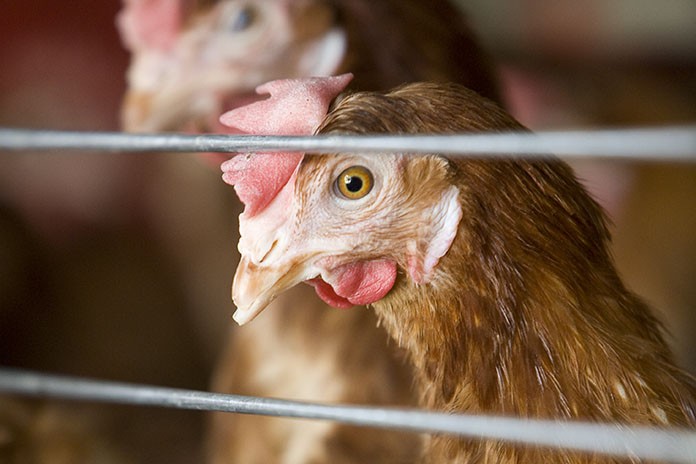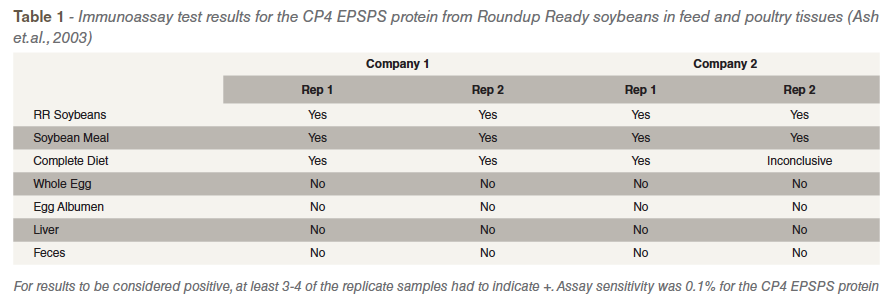
Despite all of the positive effects of modern technologies to improve corn and soybean yields, the consumer often has a different perception of the value of GMO crops. Unfortunately, there is a fear of GMO material and GM proteins in poultry feedstuffs surviving the digestive process and being deposited into the egg or poultry meat.
Insertion of new genetically modified proteins into corn and soybean plants/seeds has enabled the crop industry to build resistance to insects such as the corn rootworm, corn borer, and cutworm, decreasing use of pesticides. Development of Roundup Ready Soybeans has enabled farmers to spray their soybean fields with Roundup to control pests, increase yields and reduce extensive field cultivation and erosion. Protein digestion in the chicken is a well-described process of digestive physiology and chemical breakdown of proteins to small peptides and amino acids for absorption and further metabolism into new proteins.
Research at the University of Nebraska
Study One: “The fate of genetically modified protein from Roundup Ready Soybeans in laying hens”, 2003, JAPR 12:242-245.
 A study was conducted to determine the extent of genetically modified (GM) protein from Roundup Ready Soybeans in tissues and eggs of laying hens. Because a breakdown of the modified portion of protein was expected due to the digestive process of the hen, an immunoassay test was run. By using a double antibody sandwich format specific for the CP4 EPSPS protein, a qualitative test was performed to determine the presence of modified proteins in various samples. Raw soybeans, soybean meal, complete diet, whole egg, egg albumen, liver, and feces from laying hens were collected from two independent commercial egg producers. Roundup Ready soybeans, soybean meal, and complete diets were determined to contain the GM proteins. Whole egg, egg albumen, liver, and feces were all negative for GM protein.
A study was conducted to determine the extent of genetically modified (GM) protein from Roundup Ready Soybeans in tissues and eggs of laying hens. Because a breakdown of the modified portion of protein was expected due to the digestive process of the hen, an immunoassay test was run. By using a double antibody sandwich format specific for the CP4 EPSPS protein, a qualitative test was performed to determine the presence of modified proteins in various samples. Raw soybeans, soybean meal, complete diet, whole egg, egg albumen, liver, and feces from laying hens were collected from two independent commercial egg producers. Roundup Ready soybeans, soybean meal, and complete diets were determined to contain the GM proteins. Whole egg, egg albumen, liver, and feces were all negative for GM protein.
 In conclusion, the digestive process of the laying hen effectively broke down the GM protein from the soybean meal portion of the diet, hence no modified protein was found in the liver, egg, or feces in this brief field trial.
In conclusion, the digestive process of the laying hen effectively broke down the GM protein from the soybean meal portion of the diet, hence no modified protein was found in the liver, egg, or feces in this brief field trial.
Study 2: “The In Vivo digestive fate of the Cry3Bb1 protein in laying hens fed diets containing Mon 863 corn”, Poultry Science 87:1089-1097.
Two trials were conducted to assess the fate of the Cry3Bb1 protein from YieldGard rootworm corn (MON 863) when fed to laying hens. In the first trial, 2 diets, 1 formulated with MON 863 and 1 with conventional corn, were fed to laying hens (12 replicate cages with 4 hens/cage per treatment) for 8 wk. Daily feed intake (FI), egg production (EP), and BW were measured. Prestudy fecal samples, wk 4 and 8 egg and fecal samples, and hepatic and pectoralis tissue samples were collected from 12 killed hens and were tested for the Cry3Bb1 protein. Corn source had no significant effects on FI, EP or BW. Feces from hens fed diets containing MON 863 were positive for the Cry3Bb1 protein or proteolytic fragments (1.5 to 4.0 ppm fecal dry matter). The Cry3Bb1 protein could not be determined in eggs due to the presence of an interfering substance in all test and control eggs. No Cry3Bb1 protein was detected in hepatic and pectoralis tissue.
In the second trial, the same test and control diets were fed to 12 hens each. Six hens/treatment were sampled after 7 and 28 d. Samples included blood, feces, and digesta (crop, small and large intestine, and ceca). The Cry3Bb1 protein could not be determined in blood due to the presence of an interfering substance in all test and control blood samples. The Cry3Bb1 protein or partially digested fragments, or both, were found in the digesta sampled from all sections of the digestive tract. An estimate of 98 to>99% of the dietary Cry3Bb1 protein was digested. Overall, MON 863, when fed to laying hens, had no significant effects on FI, EP, or BW. The Cry3Bb1 protein was extensively digested, similar to that of other dietary proteins, and was not detected in hepatic or muscle tissue.
 Study 3: “Evaluation of Nutritional Equivalency of corn grain from DAS-01507-1 (Herculex* 1) in the diets o of laying hens”, 2008, JAPR 17:383-389.
Study 3: “Evaluation of Nutritional Equivalency of corn grain from DAS-01507-1 (Herculex* 1) in the diets o of laying hens”, 2008, JAPR 17:383-389.
Grain from transgenic corn line TC1507 (Herculex* I) from Pioneer Hi-Bred International Inc. and Dow AgroSciences LLC, which expresses the Cry1F protein from Bacillus thuringiensis to provide protection from lepidopteron pests of corn, was compared with its isoline equivalent and 2 conventional corn strains in a 16-wk laying hen feeding trial. Egg production and production efficiency of hens fed the diet formulated with transgenic grain TC1507 were similar to those of hens fed diets formulated with isoline or nontransgenic conventional corns.
Hens fed TC1507 had similar egg qualities as those fed nontransgenic grain diets. Diet × phase interactions were noted for Haugh unit and Roche colour fan score. Hens fed conventional corn 2 had a poorer Haugh unit score compared with hens fed the other 3 diets. Conventional corn 1 had greater levels of xanthophylls compared with the other corn treatments, resulting in increased Roche colour fan score for eggs produced by hens fed this diet. Overall, hens fed the transgenic Herculex* I corn grain containing the Cry1F protein performed as well as hens fed the isoline equivalent of Herculex* I and hens fed the conventional corn grains.
 Conclusion
Conclusion
Roundup Ready soybean GMO protein is detectable by ELISA tests in soybean meal and complete diets fed to layer chickens at concentrations above 0.1%.
No Roundup Ready soybean GM protein was detectable in whole egg, egg albumen, liver, or excreta tissue. These results were confirmed by two separate labs for egg protein.
The laying hen is adept at digesting soybean meal protein and corn GMO to a stage at which no detectable intact GMO material is absorbed or deposited in tissues such as liver and eggs. GMO corn is nutrient equivalent to conventional in value and performance in laying hens.
References are available on request. From MPF Convention Proceedings.
















